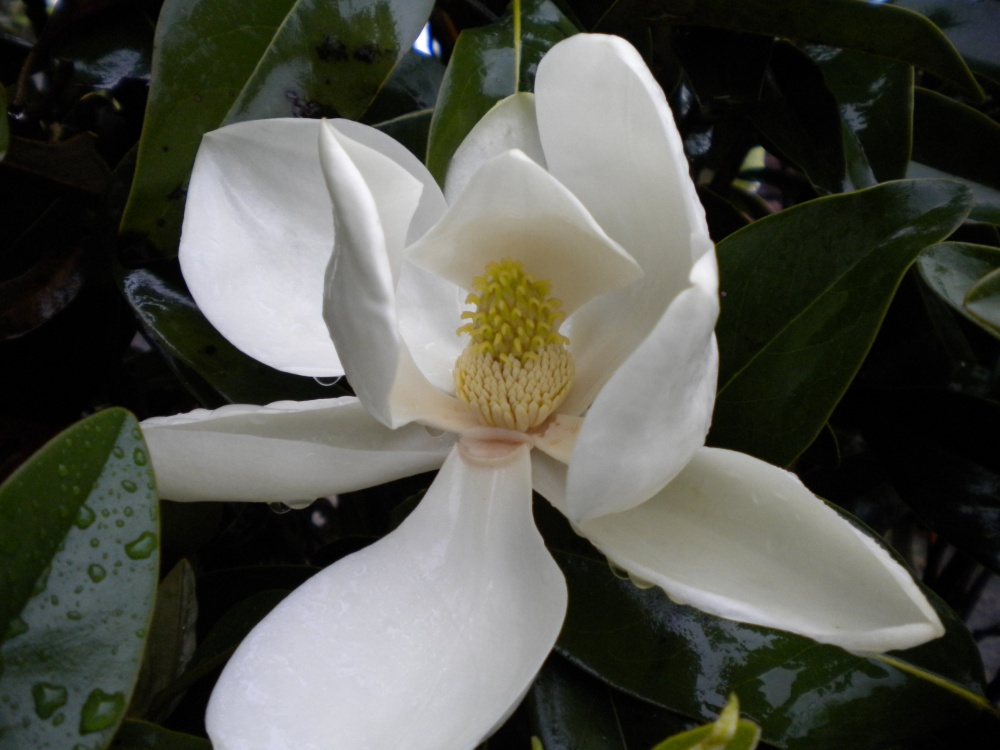The Chinese dogwoods (Cornus kousa, below) are glorious this mid May. The fast growing, but often sporadic blooming ‘Galilean’ and variegated leaf ‘Wolf Eyes’ are flowering more heavily than I can recall. The pink ‘Satomi’ is a dependable bloomer, but it’s flowers have only the faintest hint of pink this year, not uncommon for Satomi or the hybrid Stellar Pink dogwoods.
I fail to understand why Chinese dogwoods, and the hybrids introduced by Rutgers University, are not more popular, for they are outstanding in bloom and completely carefree. I am particularly fond of our native dogwood (Cornus florida), but they are a bit difficult to transplant and prone to a variety of diseases, so for most gardens the Chinese varieties are more desirable. Whenever in doubt, I believe the proper course of action is to plant both so that you’ll have blooms in April, May, and into June.
I have decided that the most under appreciated flowering tree is the Japanese Tree Lilac (Syringa reticulata ‘Ivory Silk’, below). Visitors to my garden when it’s blooming are often stunned by the quantity of twelve inch wide panicles of creamy white flowers on this nearly thirty foot tall tree. While many lilacs are plagued by mildews, Ivory Silk is not troubled at all. It grows larger than many flowering trees, but its rounded upright form consumes considerably less space than most flowering cherries. With its upright branching, I have seen tree lilacs planted in close proximity to decks and patios without ill effect from low hanging limbs.
The Southern magnolias (Magnolia grandiflora ‘Bracken’s Brown Beauty’, blooming below) Alta, Bracken’s Brown Beauty, and Greenback suffered considerable injury from the weight of the heavy snow this winter, and it will be years before the damage is repaired. Fortunately, the three magnolias are planted where they are least conspicuous, so there was no question that they would be allowed the time to heal. Alta suffered the least, but the Bracken’s and Greenback took the brunt of the storm. Limbs that were bent, but not broken are beginning to bloom, beauty amid the destruction.
The deciduous Bigleaf magnolia (Magnolia macrophylla, in bloom below) suffered no injury from snow, and is now nearly in full bloom, though many flowers are so high up that they cannot be seen. The flowers are similar to Southern magnolia’s, but larger, as is the growth of this monstrous tree that is inappropriate for any but the largest properties. My garden is not sufficiently spacious for the bigleaf, but there it is, casting dense shade over a wide area. If you are curious, and suspect that you have enough space, I should also divulge that the huge leaves are a dull green, and the tree’s texture is coarse with little ornamental value. Despite these arguments to the contrary, it is one of my favorites.
Black Lace elderberry (Sambucus nigra ‘Black Lace’, below) has been touted by some in the nursery trade as a heat tolerant substitute for Japanese maples, with dark, deeply dissected leaves, and large flat clusters of small white flowers. Black Lace is nice enough as a shrub, but I would not trade the most bedraggled maple for one. 
I have roses here and there through the garden, from the start to test the vigor and pest resistance that was purported by Flower Carpet and Knockout roses. I have found that in addition to pest and disease resistance the Knockouts are fine flowering shrubs, and in fact people who dismiss roses as high maintenance will inevitably settle for lesser plants.
I have photographed and featured the Red Knockout several times, and it is without doubt the best and most vigorous of the group, but the newest, Sunny Knockout (below) exhibits the characteristic resistance to black spot and reblooms through the summer. The only issue I have with Sunny is that the bright yellow color lasts for a day only, then fades to cream. Still, a delightful shrub.
After Knockout roses were introduced a number of other roses were marketed as “similar to Knockout”, or “from Knockout parentage”, which of course is not to say that those roses inherit any of the positive characteristics of Knockout. This is my experience with ‘Home Run’ (below), with a deeper red than the cherry red Knockout Red, but apparently little of the vigor. In it’s fourth year now, I keep waiting for it to explode in growth, but I don’t think Home Run has it in it. 
I planted the first Drift groundcover roses (Drift Red below) three years ago, and at first I was quite disappointed. First year growth was weak, and in a wet season leaves dropped by the dozens on the small plants. Last year they showed more resistance to spotting and leaf drop, grew full, and bloomed from mid spring into early fall. The plants stay relatively compact (for a rose) and I heartily recommend them over the Flower Carpet roses that proved not to be such a groundcover or to be as disease resistant as claimed.
Indigo (Indigofera kirilowii, below) is a subshrub that is carefree, except that it will often need to be cut nearly to the ground in late winter in a similar manner to buddleias and carypoteris. Branches sucker from the base to slowly increase the plant’s spread.
The clay soils in much of Virginia are not conducive to the long term health of rhododendrons, but ‘Roseum Elegans’ (below) is as tough as they come. As long as their roots remain undisturbed by scratching to remove weeds, or even to add mulch, the Roseum rhododendrons will grow old along with the gardener.

One Comment Add yours